【OpenGauss源码学习 —— 执行算子(hash join 算子)】
执行算子(hash join 算子)
- 连接算子
- hash join算子
- ExecInitHashJoin函数
- HashJoinState结构体
- TupleTableSlot 结构体
- JoinState结构体
- PlanState结构体
- ExecInitHashJoin函数部分代码介绍
- ExecHashJoin函数
- 调试信息
- ExecEndHashJoin函数
- ExecReScanHashJoin函数
- 总结
声明:本文的部分内容参考了他人的文章。在编写过程中,我们尊重他人的知识产权和学术成果,力求遵循合理使用原则,并在适用的情况下注明引用来源。
本文主要参考了 OpenGauss1.1.0 的开源代码和《OpenGauss数据库源码解析》一书
连接算子
连接算子用于处理表关联,openGauss支持 12 种连接类型(inner join、left join、right join、full join、semi join、anti join等),提供了 3 种连接算子:hash join、merge join、nested loop join 算子;本文先来看看hash join 算子。
hash join算子
hash join 算子用于 hash 连接处理,对应的代码源文件是“nodeHashJoin.cpp”。hash 连接是做大数据集连接时的常用方式,优化器使用两个表中较小的表(或数据源)利用连接键在内存中建立哈希表,然后扫描较大的表并探测哈希表,找出与哈希表匹配的行。这种方式适用于较小的表完全可以放于内存中的情况,这样总成本就是访问两个表的成本之和。但是在表很大的情况下并不能完全放入内存,执行器会将它分割成若干不同的分区,不能放入内存的部分就把该分区写入磁盘的临时段,此时要有较大的临时段从而尽量提高 I/O 的性能。算子对应的主要函数如下表所示。
| 主要函数 | 说 明 |
|---|---|
| ExecInitHashJoin | 初始化 hash join 状态节点 |
| ExecHashJoin | 利用哈希表迭代获取元组 |
| ExecEndHashJoin | 清理 hash join 状态节点 |
| ExecReScanHashJoin | 重置 hash join 状态节点 |
为了更好地理解和学习 hash join 算子的相关操作,我们还是从一个实际案例来入手吧。首先执行以下 sql 语句:
-- 创建 orders 表
CREATE TABLE orders (order_id INT,customer_id INT,order_date DATE
);-- 创建 customers 表
CREATE TABLE customers (customer_id INT,customer_name VARCHAR(100)
);-- 插入一些数据
INSERT INTO orders VALUES (1, 101, '2023-08-01');
INSERT INTO orders VALUES (2, 102, '2023-08-02');
INSERT INTO customers VALUES (101, 'Alice');
INSERT INTO customers VALUES (102, 'Bob');-- 执行连接查询
SELECT o.order_id, c.customer_name, o.order_date
FROM orders o
INNER JOIN customers c ON o.customer_id = c.customer_id;order_id | customer_name | order_date
----------+---------------+---------------------1 | Alice | 2023-08-01 00:00:002 | Bob | 2023-08-02 00:00:00
(2 rows)
ExecInitHashJoin函数
首先,在函数 ExecInitHashJoin 中插入断点,调试信息如下,通过打印可以看到函数的调用关系。
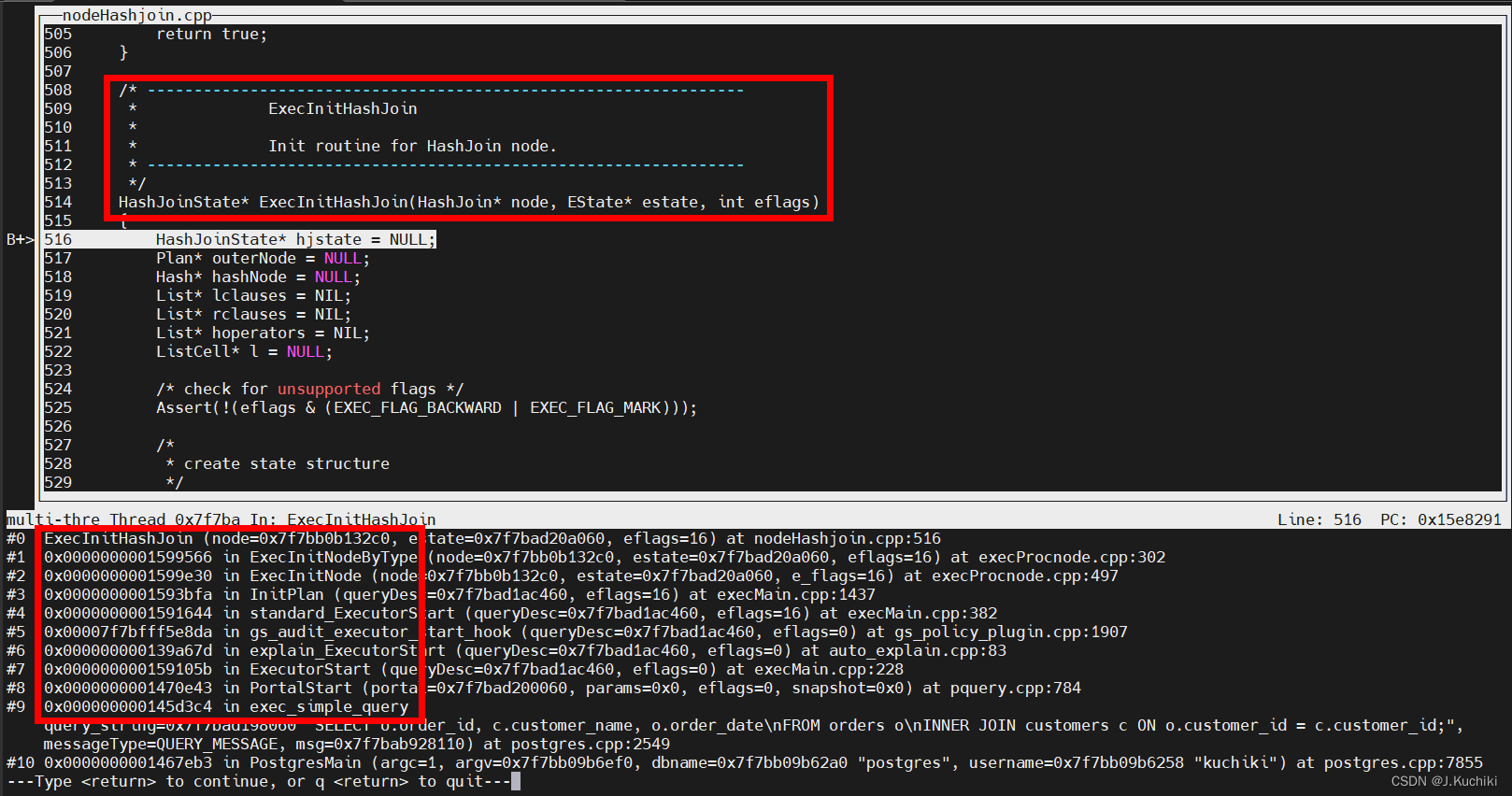
我们来看一下 ExecInitHashJoin 函数的源码吧:(路径:src/gausskernel/runtime/executor/nodeHashjoin.cpp)。
/* ----------------------------------------------------------------* ExecInitHashJoin** Init routine for HashJoin node.* ----------------------------------------------------------------*/
HashJoinState* ExecInitHashJoin(HashJoin* node, EState* estate, int eflags)
{HashJoinState* hjstate = NULL;Plan* outerNode = NULL;Hash* hashNode = NULL;List* lclauses = NIL;List* rclauses = NIL;List* hoperators = NIL;ListCell* l = NULL;/* check for unsupported flags */Assert(!(eflags & (EXEC_FLAG_BACKWARD | EXEC_FLAG_MARK)));/** create state structure*/hjstate = makeNode(HashJoinState);hjstate->js.ps.plan = (Plan*)node;hjstate->js.ps.state = estate;hjstate->hj_streamBothSides = node->streamBothSides;hjstate->hj_rebuildHashtable = node->rebuildHashTable;/** Miscellaneous initialization** create expression context for node*/ExecAssignExprContext(estate, &hjstate->js.ps);/** initialize child expressions*/hjstate->js.ps.targetlist = (List*)ExecInitExpr((Expr*)node->join.plan.targetlist, (PlanState*)hjstate);hjstate->js.ps.qual = (List*)ExecInitExpr((Expr*)node->join.plan.qual, (PlanState*)hjstate);hjstate->js.jointype = node->join.jointype;hjstate->js.joinqual = (List*)ExecInitExpr((Expr*)node->join.joinqual, (PlanState*)hjstate);hjstate->js.nulleqqual = (List*)ExecInitExpr((Expr*)node->join.nulleqqual, (PlanState*)hjstate);hjstate->hashclauses = (List*)ExecInitExpr((Expr*)node->hashclauses, (PlanState*)hjstate);/** initialize child nodes** Note: we could suppress the REWIND flag for the inner input, which* would amount to betting that the hash will be a single batch. Not* clear if this would be a win or not.*/outerNode = outerPlan(node);hashNode = (Hash*)innerPlan(node);outerPlanState(hjstate) = ExecInitNode(outerNode, estate, eflags);innerPlanState(hjstate) = ExecInitNode((Plan*)hashNode, estate, eflags);/** tuple table initialization*///这两句代码为 Hash Join 算子节点初始化了结果元组槽和外部输入表的元组槽,以便在执行过程中进行计算和数据处理。// 初始化 Hash Join 算子节点的结果元组槽(TupleTableSlot),它是用于存储计算结果的容器。ExecInitResultTupleSlot(estate, &hjstate->js.ps);// 初始化 Hash Join 算子节点的额外元组槽,这个槽用于存储外部输入表的元组。hjstate->hj_OuterTupleSlot = ExecInitExtraTupleSlot(estate);/* set up null tuples for outer joins, if needed */switch (node->join.jointype) {case JOIN_INNER:case JOIN_SEMI:case JOIN_RIGHT_SEMI:break;case JOIN_LEFT:case JOIN_ANTI:case JOIN_LEFT_ANTI_FULL:hjstate->hj_NullInnerTupleSlot = ExecInitNullTupleSlot(estate, ExecGetResultType(innerPlanState(hjstate)));break;case JOIN_RIGHT:case JOIN_RIGHT_ANTI:case JOIN_RIGHT_ANTI_FULL:hjstate->hj_NullOuterTupleSlot = ExecInitNullTupleSlot(estate, ExecGetResultType(outerPlanState(hjstate)));break;case JOIN_FULL:hjstate->hj_NullOuterTupleSlot = ExecInitNullTupleSlot(estate, ExecGetResultType(outerPlanState(hjstate)));hjstate->hj_NullInnerTupleSlot = ExecInitNullTupleSlot(estate, ExecGetResultType(innerPlanState(hjstate)));break;default:ereport(ERROR,(errcode(ERRCODE_UNRECOGNIZED_NODE_TYPE),errmodule(MOD_EXECUTOR),errmsg("unrecognized join type: %d for hashjoin", (int)node->join.jointype)));}/** now for some voodoo. our temporary tuple slot is actually the result* tuple slot of the Hash node (which is our inner plan). we can do this* because Hash nodes don't return tuples via ExecProcNode() -- instead* the hash join node uses ExecScanHashBucket() to get at the contents of* the hash table. -cim 6/9/91*/{// 从一个 Hash Join 算子状态结构体 hjstate 中获取内部计划(inner plan)的状态,并将其赋值给一个名为 hashstate 的指针变量HashState* hashstate = (HashState*)innerPlanState(hjstate);// 从 Hash 算子的状态结构体 hashstate 中获取一个指向结果元组槽(TupleTableSlot)的指针,并将其赋值给变量 slot。TupleTableSlot* slot = hashstate->ps.ps_ResultTupleSlot;// 将上述获取到的结果元组槽指针赋值给 Hash Join 算子状态结构体 hjstate 的成员变量 hj_HashTupleSlot。hjstate->hj_HashTupleSlot = slot;}/** initialize tuple type and projection info* result tupleSlot only contains virtual tuple, so the default* tableAm type is set to HEAP.*/// 为 Hash Join 算子状态结构体中的计划状态(PlanState)分配结果类型// 这将根据目标列表(targetlist)来推断结果的类型,并且使用 TAM_HEAP 类型分配存储空间。ExecAssignResultTypeFromTL(&hjstate->js.ps, TAM_HEAP);// 为 Hash Join 算子状态结构体中的计划状态分配投影信息(ProjectionInfo)。// 投影信息用于对结果进行投影,通常包括计算目标列表中的表达式并生成结果元组。ExecAssignProjectionInfo(&hjstate->js.ps, NULL);// 为 Hash Join 算子状态结构体中的外部元组槽(hj_OuterTupleSlot)设置描述符。// 它将外部元组槽与外部计划(左输入)的结果类型进行关联,以确保正确的元组类型和数据存储。ExecSetSlotDescriptor(hjstate->hj_OuterTupleSlot, ExecGetResultType(outerPlanState(hjstate)));/** initialize hash-specific info*/hjstate->hj_HashTable = NULL;hjstate->hj_FirstOuterTupleSlot = NULL;hjstate->hj_CurHashValue = 0;hjstate->hj_CurBucketNo = 0;hjstate->hj_CurSkewBucketNo = INVALID_SKEW_BUCKET_NO;hjstate->hj_CurTuple = NULL;/** Deconstruct the hash clauses into outer and inner argument values, so* that we can evaluate those subexpressions separately. Also make a list* of the hash operator OIDs, in preparation for looking up the hash* functions to use.*/// 初始化存储用于连接的哈希表的关键信息列表、哈希操作符列表和连接状态List* lclauses = NIL; // 用于存储左侧关键信息列表List* rclauses = NIL; // 用于存储右侧关键信息列表List* hoperators = NIL; // 用于存储哈希操作符列表foreach (l, hjstate->hashclauses) {FuncExprState* fstate = (FuncExprState*)lfirst(l); // 获取函数表达式状态OpExpr* hclause = NULL; // 声明一个操作符表达式Assert(IsA(fstate, FuncExprState)); // 确保是函数表达式状态hclause = (OpExpr*)fstate->xprstate.expr; // 获取操作符表达式Assert(IsA(hclause, OpExpr)); // 确保是操作符表达式lclauses = lappend(lclauses, linitial(fstate->args)); // 将左侧关键信息添加到列表rclauses = lappend(rclauses, lsecond(fstate->args)); // 将右侧关键信息添加到列表hoperators = lappend_oid(hoperators, hclause->opno); // 将哈希操作符添加到列表}// 设置 Hash Join 算子状态结构体中的相关属性hjstate->hj_OuterHashKeys = lclauses; // 设置左侧关键信息列表hjstate->hj_InnerHashKeys = rclauses; // 设置右侧关键信息列表hjstate->hj_HashOperators = hoperators; // 设置哈希操作符列表// 子 Hash 节点需要评估内部哈希键((HashState*)innerPlanState(hjstate))->hashkeys = rclauses;hjstate->js.ps.ps_TupFromTlist = false; // 初始化是否从目标列表获取元组标志hjstate->hj_JoinState = HJ_BUILD_HASHTABLE; // 设置连接状态为构建哈希表hjstate->hj_MatchedOuter = false; // 初始化是否匹配外部表元组的标志hjstate->hj_OuterNotEmpty = false; // 初始化外部表是否非空的标志return hjstate;
}
函数的三个入参分别解释如下:
- HashJoin* node:这是要初始化的 Hash Join 节点,它是一个指向 HashJoin 结构体的指针,表示查询计划中的 Hash Join 算子节点。
调试信息如下:
- EState* estate:这是查询的执行状态对象,它是一个指向 EState 结构体的指针,用于存储查询执行过程中的状态信息。
- int eflags:这是一个表示执行标志位的整数,用于指定执行 Hash Join 算子时的一些特定选项和标志。
HashJoinState结构体
其中,HashJoinState 在执行 Hash Join 算子时起着关键的作用,它用于存储 Hash Join 算子在运行过程中的各种状态信息和参数。
hash join 算子对应的 状态节点 HashJoinState 代码如下:(路径:src/include/nodes/execnodes.h)
// 定义 Hash Join 算子的状态结构体
typedef struct HashJoinState {JoinState js; /* 继承 NodeTag 的 JoinState 结构体 */List* hashclauses; /* 哈希连接的表达式状态列表 */List* hj_OuterHashKeys; /* 外表的哈希键表达式状态列表 */List* hj_InnerHashKeys; /* 内表的哈希键表达式状态列表 */List* hj_HashOperators; /* 哈希操作符 OID 列表 */HashJoinTable hj_HashTable; /* 哈希连接表 */uint32 hj_CurHashValue; /* 当前哈希值 */int hj_CurBucketNo; /* 当前哈希桶编号 */int hj_CurSkewBucketNo; /* 当前倾斜哈希桶编号 */HashJoinTuple hj_CurTuple; /* 当前哈希连接元组 *//* hj_PreTuple 是一个指向 hj_CurTuple 之前的元组的指针,用于在哈希表中删除匹配的元组,特别用于右半连接和反连接 */HashJoinTuple hj_PreTuple;TupleTableSlot* hj_OuterTupleSlot; /* 外表元组槽 */TupleTableSlot* hj_HashTupleSlot; /* 哈希表元组槽 */TupleTableSlot* hj_NullOuterTupleSlot; /* 用于空的外表元组槽 */TupleTableSlot* hj_NullInnerTupleSlot; /* 用于空的内表元组槽 */TupleTableSlot* hj_FirstOuterTupleSlot;/* 第一个外表元组槽 */int hj_JoinState; /* 哈希连接的当前状态 */bool hj_MatchedOuter; /* 是否匹配了外表元组 */bool hj_OuterNotEmpty; /* 外表是否不为空 */bool hj_streamBothSides; /* 是否同时处理外表和内表的元组流 */bool hj_rebuildHashtable; /* 是否需要重建哈希表 */} HashJoinState;
TupleTableSlot 结构体
TupleTableSlot 的结构体,该结构体表示一个元组槽,用于在数据库系统中处理元组的存储、传递和处理。源码如下:(路径:src/include/executor/tuptable.h)
typedef struct TupleTableSlot {NodeTag type; // 结构体的类型标记bool tts_isempty; // 标记槽是否为空bool tts_shouldFree; // 是否应该释放 tts_tuple 内存bool tts_shouldFreeMin; // 是否应该释放 tts_mintuple 内存bool tts_slow; // 用于 slot_deform_tuple 的保存状态Tuple tts_tuple; // 物理元组,如果是虚拟的则为 NULL#ifdef PGXC/** PGXC 扩展以支持从远程 Datanode 发送的元组。*/char* tts_dataRow; // DataRow 格式中的元组数据int tts_dataLen; // 数据行的实际长度bool tts_shouldFreeRow; // 是否应该释放 tts_dataRow 内存struct AttInMetadata* tts_attinmeta; // 存储从 DataRow 提取值的信息Oid tts_xcnodeoid; // 来自哪个节点的数据行的 OidMemoryContext tts_per_tuple_mcxt; // 每个元组的内存上下文
#endifTupleDesc tts_tupleDescriptor; // 槽的元组描述符MemoryContext tts_mcxt; // 槽本身所在的上下文Buffer tts_buffer; // 元组的缓冲区,无效则为 InvalidBufferint tts_nvalid; // tts_values 中有效值的数量Datum* tts_values; // 每个属性的当前值bool* tts_isnull; // 每个属性的当前是否为 NULL 标记MinimalTuple tts_mintuple; // 最小元组,没有则为 NULLHeapTupleData tts_minhdr; // 仅用于最小元组的工作区long tts_off; // slot_deform_tuple 的保存状态long tts_meta_off; // slot_deform_cmpr_tuple 的保存状态TableAmType tts_tupslotTableAm; // 槽的元组表类型
} TupleTableSlot;调试信息如下:

JoinState结构体
JoinState 结构体如下:(路径:src/include/nodes/execnodes.h)
/* ----------------* JoinState information** Superclass for state nodes of join plans.* ----------------*/
typedef struct JoinState {PlanState ps; /* 计划状态,用于继承基本的节点信息 */JoinType jointype; /* 连接的类型,描述连接的方式(内连接、左连接、右连接等) */List* joinqual; /* 连接条件表达式列表(除了 ps.qual 外的其他条件) */List* nulleqqual; /* 用于处理 NULL 值的连接条件表达式列表 */
} JoinState;PlanState结构体
PlanState 结构体如下:(路径:src/include/nodes/execnodes.h)
/* ----------------* PlanState node** We never actually instantiate any PlanState nodes; this is just the common* abstract superclass for all PlanState-type nodes.* ----------------*/
typedef struct PlanState {NodeTag type; /* 节点类型标签 */Plan* plan; /* 关联的 Plan 节点 */EState* state; /* 执行时,各个节点的状态指向整个顶层 Plan 的一个 EState */Instrumentation* instrument; /* 可选的运行时统计信息 *//** 所有 Plan 类型共用的结构数据。这些链接到子状态树的链接与相关的计划树中的链接平行(除了 subPlan 列表,在计划树中不存在)。*/List* targetlist; /* 在该节点计算的目标列表 */List* qual; /* 隐式的 AND 连接的条件 */struct PlanState* lefttree; /* 输入的计划树(可能有多个) */struct PlanState* righttree;List* initPlan; /* Init 子计划节点(无相关的表达式子查询) */List* subPlan; /* 在我的表达式中的 SubPlanState 节点 *//** 管理基于参数变化的重新扫描的状态。*/Bitmapset* chgParam; /* 变化的 Params 的 ID 集合 */HbktScanSlot hbktScanSlot;/** 大多数(如果不是全部)节点类型都需要的其他运行时状态。*/TupleTableSlot* ps_ResultTupleSlot; /* 存储我的结果元组的槽位 */ExprContext* ps_ExprContext; /* 节点的表达式计算上下文 */ProjectionInfo* ps_ProjInfo; /* 进行元组投影的信息 */bool ps_TupFromTlist; /* 处理目标列表中的集合值函数的状态标志 */bool vectorized; /* 是否为矢量化? */MemoryContext nodeContext; /* 此节点的内存上下文 */bool earlyFreed; /* 节点内存是否已释放? */uint8 stubType; /* 节点存根执行类型,参见 @PlanStubType */vectarget_func jitted_vectarget; /* 指向代码生成的目标列表表达式的 LLVM IR 函数指针。 *//** 描述当前计划节点中的问题,主要用于数据倾斜和不准确的行数的问题去重复*/List* plan_issues;bool recursive_reset; /* 节点是否已经重置? */bool qual_is_inited;int64 ps_rownum; /* 存储当前行号 */
} PlanState;
ExecInitHashJoin函数部分代码介绍
下面,我们来拆分的看一下 ExecInitHashJoin 函数吧。这里只介绍一些重点部分,其余部分可参考源码中的注释。先看如下代码段:
/*
* initialize child expressions
*/
hjstate->js.ps.targetlist = (List*)ExecInitExpr((Expr*)node->join.plan.targetlist, (PlanState*)hjstate);
hjstate->js.ps.qual = (List*)ExecInitExpr((Expr*)node->join.plan.qual, (PlanState*)hjstate);
hjstate->js.jointype = node->join.jointype;
hjstate->js.joinqual = (List*)ExecInitExpr((Expr*)node->join.joinqual, (PlanState*)hjstate);
hjstate->js.nulleqqual = (List*)ExecInitExpr((Expr*)node->join.nulleqqual, (PlanState*)hjstate);
hjstate->hashclauses = (List*)ExecInitExpr((Expr*)node->hashclauses, (PlanState*)hjstate);
以第一句(hjstate->js.ps.targetlist = (List*)ExecInitExpr((Expr*)node->join.plan.targetlist, (PlanState*)hjstate);)为例进行分析:
这句代码的作用是将 HashJoinState 结构体中的 targetlist 字段初始化为经过表达式初始化函数 ExecInitExpr 处理后的结果。
函数 ExecInitExpr 是初始化表达式节点的函数,其作用是为给定的表达式节点创建执行时所需的状态结构体,并将该节点进行适当的初始化。
调试信息如下:
以下两句代码是在获取 Hash Join 节点的输入子计划,其中:
- outerPlan(node):获取了 Hash Join 节点的外部输入子计划,也就是左侧的输入。
- (Hash*)innerPlan(node):获取了 Hash Join 节点的内部输入子计划,也就是右侧的输入,并将其强制转换为 Hash 类型的指针。
outerNode = outerPlan(node);hashNode = (Hash*)innerPlan(node);
调试信息如下:


以下这段 switch 语句是用于为 Hash Join 算子节点设置外连接(outer join)操作所需的空元组(null tuples)。外连接是一种连接操作,它不仅返回符合连接条件的元组,还会返回没有匹配的元组,并用 NULL 值填充缺失的列。
/* set up null tuples for outer joins, if needed */switch (node->join.jointype) {case JOIN_INNER:case JOIN_SEMI:case JOIN_RIGHT_SEMI:break;case JOIN_LEFT:case JOIN_ANTI:case JOIN_LEFT_ANTI_FULL:hjstate->hj_NullInnerTupleSlot = ExecInitNullTupleSlot(estate, ExecGetResultType(innerPlanState(hjstate)));break;case JOIN_RIGHT:case JOIN_RIGHT_ANTI:case JOIN_RIGHT_ANTI_FULL:hjstate->hj_NullOuterTupleSlot = ExecInitNullTupleSlot(estate, ExecGetResultType(outerPlanState(hjstate)));break;case JOIN_FULL:hjstate->hj_NullOuterTupleSlot = ExecInitNullTupleSlot(estate, ExecGetResultType(outerPlanState(hjstate)));hjstate->hj_NullInnerTupleSlot = ExecInitNullTupleSlot(estate, ExecGetResultType(innerPlanState(hjstate)));break;default:ereport(ERROR,(errcode(ERRCODE_UNRECOGNIZED_NODE_TYPE),errmodule(MOD_EXECUTOR),errmsg("unrecognized join type: %d for hashjoin", (int)node->join.jointype)));}
具体来说,这段代码做了以下工作:
- 根据连接类型
(node->join.jointype)的不同,决定是否需要设置空元组。- 对于内连接(INNER JOIN)、半连接(SEMI JOIN)和右半连接(RIGHT SEMI JOIN),不需要设置空元组,所以这些情况下代码直接跳过。
- 对于左连接(LEFT JOIN)、反向半连接(ANTI JOIN)以及左反全连接(LEFT ANTI FULL JOIN),需要为内部表设置空元组。这样在左连接中,如果没有匹配的内部表元组,外部表的元组将会与一个 NULL 值填充的空元组进行连接。
- 对于右连接(RIGHT JOIN)、反向右半连接(RIGHT ANTI JOIN)以及右反全连接(RIGHT ANTI FULL JOIN),需要为外部表设置空元组。这样在右连接中,如果没有匹配的外部表元组,内部表的元组将会与一个 NULL 值填充的空元组进行连接。
- 对于全连接(FULL JOIN),需要为内部表和外部表都设置空元组,以满足连接操作的要求。
ExecHashJoin函数
ExecHashJoin 函数的作用是执行 Hash Join 连接操作,它将两个输入关系(外部和内部)的元组按照给定的连接条件进行连接,并输出满足条件的连接结果。在 Hash Join 中,通过构建哈希表来加速连接过程。在函数 ExecInitHashJoin 中插入断点,调试信息如下,通过打印可以看到函数的调用关系。

ExecHashJoin 函数源码如下:(路径:src/gausskernel/runtime/executor/nodeHashjoin.cpp)
/* ----------------------------------------------------------------* ExecHashJoin** This function implements the Hybrid Hashjoin algorithm.** Note: the relation we build hash table on is the "inner"* the other one is "outer".* ----------------------------------------------------------------*/
/* return: a tuple or NULL */
TupleTableSlot* ExecHashJoin(HashJoinState* node)
{PlanState* outerNode = NULL; // 外部计划节点的状态HashState* hashNode = NULL; // 哈希节点的状态List* joinqual = NIL; // 连接条件List* otherqual = NIL; // 其他条件ExprContext* econtext = NULL; // 表达式计算上下文ExprDoneCond isDone; // 表达式计算结束状态HashJoinTable hashtable; // 哈希连接表TupleTableSlot* outerTupleSlot = NULL; // 外部元组槽uint32 hashvalue; // 哈希值int batchno; // 哈希批次号MemoryContext oldcxt; // 旧内存上下文JoinType jointype; // 连接类型/** 从 HashJoin 节点获取信息*/joinqual = node->js.joinqual; // 获取连接条件otherqual = node->js.ps.qual; // 获取其他条件hashNode = (HashState*)innerPlanState(node); // 获取内部计划节点的状态,即哈希节点状态outerNode = outerPlanState(node); // 获取外部计划节点的状态hashtable = node->hj_HashTable; // 获取哈希连接表econtext = node->js.ps.ps_ExprContext; // 获取表达式计算上下文jointype = node->js.jointype; // 获取连接类型/** 检查是否仍在从先前的连接元组中投影出元组* 这是因为在投影表达式中存在返回集合的函数* 如果是这样,尝试投影另一个元组*/if (node->js.ps.ps_TupFromTlist) {TupleTableSlot* result = NULL;// 通过执行投影操作生成新的元组result = ExecProject(node->js.ps.ps_ProjInfo, &isDone);// 如果投影操作返回多个结果,直接返回当前结果if (isDone == ExprMultipleResult)return result;/* 完成当前源元组的处理... */node->js.ps.ps_TupFromTlist = false;}/** Reset per-tuple memory context to free any expression evaluation* storage allocated in the previous tuple cycle. Note this can't happen* until we're done projecting out tuples from a join tuple.*/// 重置一个表达式上下文ResetExprContext(econtext);/** run the hash join state machine* 运行哈希联接状态机*/for (;;) {switch (node->hj_JoinState) {case HJ_BUILD_HASHTABLE: {/** First time through: build hash table for inner relation.*/Assert(hashtable == NULL);/** If the outer relation is completely empty, and it's not* right/full join, we can quit without building the hash* table. However, for an inner join it is only a win to* check this when the outer relation's startup cost is less* than the projected cost of building the hash table.* Otherwise it's best to build the hash table first and see* if the inner relation is empty. (When it's a left join, we* should always make this check, since we aren't going to be* able to skip the join on the strength of an empty inner* relation anyway.)** If we are rescanning the join, we make use of information* gained on the previous scan: don't bother to try the* prefetch if the previous scan found the outer relation* nonempty. This is not 100% reliable since with new* parameters the outer relation might yield different* results, but it's a good heuristic.** The only way to make the check is to try to fetch a tuple* from the outer plan node. If we succeed, we have to stash* it away for later consumption by ExecHashJoinOuterGetTuple.*/// remove node->hj_streamBothSides after stream hang problem sloved.if (HJ_FILL_INNER(node)) {/* no chance to not build the hash table */node->hj_FirstOuterTupleSlot = NULL;} else if ((HJ_FILL_OUTER(node) || (outerNode->plan->startup_cost < hashNode->ps.plan->total_cost &&!node->hj_OuterNotEmpty)) &&!node->hj_streamBothSides) {node->hj_FirstOuterTupleSlot = ExecProcNode(outerNode);if (TupIsNull(node->hj_FirstOuterTupleSlot)) {node->hj_OuterNotEmpty = false;/** If the outer relation is completely empty, and it's not right/full join,* we should deinit the consumer in right tree earlier.* It should be noticed that we can not do early deinit * within predpush.*/
#ifdef ENABLE_MULTIPLE_NODESif (((PlanState*)node) != NULL && !CheckParamWalker((PlanState*)node)) {ExecEarlyDeinitConsumer((PlanState*)node);}
#endifExecEarlyFree((PlanState*)node);EARLY_FREE_LOG(elog(LOG, "Early Free: HashJoin early return NULL"" at node %d, memory used %d MB.", (node->js.ps.plan)->plan_node_id,getSessionMemoryUsageMB()));return NULL;} elsenode->hj_OuterNotEmpty = true;} elsenode->hj_FirstOuterTupleSlot = NULL;/** create the hash table, sometimes we should keep nulls*/oldcxt = MemoryContextSwitchTo(hashNode->ps.nodeContext);hashtable = ExecHashTableCreate((Hash*)hashNode->ps.plan, node->hj_HashOperators,HJ_FILL_INNER(node) || node->js.nulleqqual != NIL);MemoryContextSwitchTo(oldcxt);node->hj_HashTable = hashtable;/** execute the Hash node, to build the hash table*/WaitState oldStatus = pgstat_report_waitstatus(STATE_EXEC_HASHJOIN_BUILD_HASH);hashNode->hashtable = hashtable;hashNode->ps.hbktScanSlot.currSlot = node->js.ps.hbktScanSlot.currSlot;(void)MultiExecProcNode((PlanState*)hashNode);(void)pgstat_report_waitstatus(oldStatus);/* Early free right tree after hash table built */ExecEarlyFree((PlanState*)hashNode);EARLY_FREE_LOG(elog(LOG, "Early Free: Hash Table for HashJoin"" is built at node %d, memory used %d MB.",(node->js.ps.plan)->plan_node_id, getSessionMemoryUsageMB()));/** If the inner relation is completely empty, and we're not* doing a left outer join, we can quit without scanning the* outer relation.*/if (hashtable->totalTuples == 0 && !HJ_FILL_OUTER(node)) {/** When hash table size is zero, no need to fetch left tree any more and* should deinit the consumer in left tree earlier.* It should be noticed that we can not do early deinit * within predpush.*/
#ifdef ENABLE_MULTIPLE_NODESif (((PlanState*)node) != NULL && !CheckParamWalker((PlanState*)node)) {ExecEarlyDeinitConsumer((PlanState*)node);}
#endifreturn NULL;}/** need to remember whether nbatch has increased since we* began scanning the outer relation*/hashtable->nbatch_outstart = hashtable->nbatch;/** Reset OuterNotEmpty for scan. (It's OK if we fetched a* tuple above, because ExecHashJoinOuterGetTuple will* immediately set it again.)*/node->hj_OuterNotEmpty = false;node->hj_JoinState = HJ_NEED_NEW_OUTER;}/* fall through */case HJ_NEED_NEW_OUTER:/** 如果没有外部元组,尝试获取下一个*/outerTupleSlot = ExecHashJoinOuterGetTuple(outerNode, node, &hashvalue);// 如果外部元组为空,表示批处理结束或可能整个连接结束if (TupIsNull(outerTupleSlot)) {if (HJ_FILL_INNER(node)) {// 准备扫描未匹配的内部元组ExecPrepHashTableForUnmatched(node);// 切换到扫描未匹配内部元组的状态node->hj_JoinState = HJ_FILL_INNER_TUPLES;} else {// 切换到需要获取新批次的状态node->hj_JoinState = HJ_NEED_NEW_BATCH;}// 继续下一次循环continue;}// 设置外部元组到执行上下文中econtext->ecxt_outertuple = outerTupleSlot;// 标记当前外部元组还未匹配node->hj_MatchedOuter = false;/** Find the corresponding bucket for this tuple in the main* hash table or skew hash table.*/// 找到当前元组对应的主哈希表或倾斜哈希表中的桶node->hj_CurHashValue = hashvalue;// 获取当前元组所属的桶编号和批次编号ExecHashGetBucketAndBatch(hashtable, hashvalue, &node->hj_CurBucketNo, &batchno);// 获取当前元组所属的倾斜桶编号(如果有)node->hj_CurSkewBucketNo = ExecHashGetSkewBucket(hashtable, hashvalue);// 将当前元组指针初始化为 NULLnode->hj_CurTuple = NULL;/** The tuple might not belong to the current batch (where* "current batch" includes the skew buckets if any).*/// 如果当前元组所属的批次编号不是当前批次,并且不属于任何倾斜桶if (batchno != hashtable->curbatch && node->hj_CurSkewBucketNo == INVALID_SKEW_BUCKET_NO) {/** 需要将这个外部元组推迟到后续批次。* 将其保存到对应的外部批次文件中。*/Assert(batchno > hashtable->curbatch);// 提取外部元组的最小元组形式MinimalTuple tuple = ExecFetchSlotMinimalTuple(outerTupleSlot);// 将元组保存到对应的外部批次文件中,同时更新溢出大小ExecHashJoinSaveTuple(tuple, hashvalue, &hashtable->outerBatchFile[batchno]);*hashtable->spill_size += sizeof(uint32) + tuple->t_len;pgstat_increase_session_spill_size(sizeof(uint32) + tuple->t_len);// 继续循环,仍然保持在 HJ_NEED_NEW_OUTER 状态continue;}/* OK, let's scan the bucket for matches */node->hj_JoinState = HJ_SCAN_BUCKET;/* Prepare for the clear-process if necessary */if (jointype == JOIN_RIGHT_ANTI || jointype == JOIN_RIGHT_SEMI)node->hj_PreTuple = NULL;/* fall through */case HJ_SCAN_BUCKET:/** We check for interrupts here because this corresponds to* where we'd fetch a row from a child plan node in other join* types.*/CHECK_FOR_INTERRUPTS();/** Scan the selected hash bucket for matches to current outer*/if (!ExecScanHashBucket(node, econtext)) {/* out of matches; check for possible outer-join fill */node->hj_JoinState = HJ_FILL_OUTER_TUPLE;continue;}/** We've got a match, but still need to test non-hashed quals.* ExecScanHashBucket already set up all the state needed to* call ExecQual.** If we pass the qual, then save state for next call and have* ExecProject form the projection, store it in the tuple* table, and return the slot.** Only the joinquals determine tuple match status, but all* quals must pass to actually return the tuple.*/if (joinqual == NIL || ExecQual(joinqual, econtext, false)) {node->hj_MatchedOuter = true;/** for right-anti join: skip and delete the matched tuple;* for right-semi join: return and delete the matched tuple;* for right-anti-full join: skip and delete the matched tuple;*/if (jointype == JOIN_RIGHT_ANTI || jointype == JOIN_RIGHT_SEMI ||jointype == JOIN_RIGHT_ANTI_FULL) {if (node->hj_PreTuple)node->hj_PreTuple->next = node->hj_CurTuple->next;else if (node->hj_CurSkewBucketNo != INVALID_SKEW_BUCKET_NO)hashtable->skewBucket[node->hj_CurSkewBucketNo]->tuples = node->hj_CurTuple->next;elsehashtable->buckets[node->hj_CurBucketNo] = node->hj_CurTuple->next;if (jointype == JOIN_RIGHT_ANTI || jointype == JOIN_RIGHT_ANTI_FULL)continue;} else {HeapTupleHeaderSetMatch(HJTUPLE_MINTUPLE(node->hj_CurTuple));/* Anti join: we never return a matched tuple */if (jointype == JOIN_ANTI || jointype == JOIN_LEFT_ANTI_FULL) {node->hj_JoinState = HJ_NEED_NEW_OUTER;continue;}/* Semi join: we'll consider returning the first match, but after* that we're done with this outer tuple */if (jointype == JOIN_SEMI)node->hj_JoinState = HJ_NEED_NEW_OUTER;}if (otherqual == NIL || ExecQual(otherqual, econtext, false)) {TupleTableSlot* result = NULL;result = ExecProject(node->js.ps.ps_ProjInfo, &isDone);if (isDone != ExprEndResult) {node->js.ps.ps_TupFromTlist = (isDone == ExprMultipleResult);return result;}} elseInstrCountFiltered2(node, 1);} else {InstrCountFiltered1(node, 1);/* For right Semi/Anti join, we set hj_PreTuple following hj_CurTuple */if (jointype == JOIN_RIGHT_ANTI || jointype == JOIN_RIGHT_SEMI)node->hj_PreTuple = node->hj_CurTuple;}break;case HJ_FILL_OUTER_TUPLE:/** The current outer tuple has run out of matches, so check* whether to emit a dummy outer-join tuple. Whether we emit* one or not, the next state is NEED_NEW_OUTER.*/node->hj_JoinState = HJ_NEED_NEW_OUTER;if (!node->hj_MatchedOuter && HJ_FILL_OUTER(node)) {/** Generate a fake join tuple with nulls for the inner* tuple, and return it if it passes the non-join quals.*/econtext->ecxt_innertuple = node->hj_NullInnerTupleSlot;if (otherqual == NIL || ExecQual(otherqual, econtext, false)) {TupleTableSlot* result = NULL;result = ExecProject(node->js.ps.ps_ProjInfo, &isDone);if (isDone != ExprEndResult) {node->js.ps.ps_TupFromTlist = (isDone == ExprMultipleResult);return result;}} elseInstrCountFiltered2(node, 1);}break;case HJ_FILL_INNER_TUPLES:/** We have finished a batch, but we are doing right/full/rightAnti join,* so any unmatched inner tuples in the hashtable have to be* emitted before we continue to the next batch.*/if (!ExecScanHashTableForUnmatched(node, econtext)) {/* no more unmatched tuples */node->hj_JoinState = HJ_NEED_NEW_BATCH;continue;}/** Generate a fake join tuple with nulls for the outer tuple,* and return it if it passes the non-join quals.*/econtext->ecxt_outertuple = node->hj_NullOuterTupleSlot;if (otherqual == NIL || ExecQual(otherqual, econtext, false)) {TupleTableSlot* result = NULL;result = ExecProject(node->js.ps.ps_ProjInfo, &isDone);if (isDone != ExprEndResult) {node->js.ps.ps_TupFromTlist = (isDone == ExprMultipleResult);return result;}} elseInstrCountFiltered2(node, 1);break;case HJ_NEED_NEW_BATCH:/** Try to advance to next batch. Done if there are no more.*/if (!ExecHashJoinNewBatch(node)) {ExecEarlyFree(outerPlanState(node));EARLY_FREE_LOG(elog(LOG, "Early Free: HashJoin Probe is done"" at node %d, memory used %d MB.",(node->js.ps.plan)->plan_node_id, getSessionMemoryUsageMB()));return NULL; /* end of join */}node->hj_JoinState = HJ_NEED_NEW_OUTER;break;default:ereport(ERROR, (errcode(ERRCODE_UNEXPECTED_NODE_STATE),errmodule(MOD_EXECUTOR), errmsg("unrecognized hashjoin state: %d", (int)node->hj_JoinState)));}}
}
可以看到 ExecHashJoin 函数已经非常的长,我们还是来拆分的看一下 吧。这里只介绍一些重点部分,其余部分可参考源码中的注释。先看如下代码段:
/** 检查是否仍在从先前的连接元组中投影出元组* 这是因为在投影表达式中存在返回集合的函数* 如果是这样,尝试投影另一个元组*/if (node->js.ps.ps_TupFromTlist) {TupleTableSlot* result = NULL;// 通过执行投影操作生成新的元组result = ExecProject(node->js.ps.ps_ProjInfo, &isDone);// 如果投影操作返回多个结果,直接返回当前结果if (isDone == ExprMultipleResult)return result;/* 完成当前源元组的处理... */node->js.ps.ps_TupFromTlist = false;}
以上代码中条件判断语句 if (node->js.ps.ps_TupFromTlist) 是在判断什么呢?
这个条件判断用于检查是否之前已经从上一个连接操作(比如上一个join)的投影表达式中返回了一个或多个元组。
什么意思?来看一个案例吧:
当进行多表连接操作时,涉及多个表的列,我们可以使用投影操作从连接结果中选择特定的列。假设有以下两个表:
- 表 employees 包含员工信息,如 employee_id、employee_name 等列。
- 表 salaries 包含员工薪资信息,如 employee_id、salary_amount 等列。
现在,我们希望进行一个内连接操作,连接 employees 表和 salaries 表,以便找到每个员工的工资信息。查询可能如下所示:
SELECT e.employee_id, e.employee_name, s.salary_amount
FROM employees e
INNER JOIN salaries s ON e.employee_id = s.employee_id;
在执行这个查询时,查询执行计划会涉及到投影操作,以便将所需的列从连接结果中选择出来。这里的 SELECT 子句中指定了需要的列:e.employee_id、e.employee_name 和 s.salary_amount。
在执行这个投影操作时,ExecProject 函数会计算投影表达式,生成满足条件的元组,包含指定的列值。如果在处理过程中发现一个员工关联了多个工资记录,那么 JOIN 操作会生成多个连接结果,其中每个连接结果都包含一个员工的不同工资记录。在这种情况下,ExecProject 可能会多次返回元组,直到所有可能的连接结果都被处理完。
其中,ExecProject 函数用于执行投影操作,它将从输入元组中选取特定的列(属性),应用投影表达式(可能包含函数调用、运算等),并生成一个新的输出元组。这个函数在数据库查询执行计划中的很多阶段都会使用,例如投影操作、投影到目标列、计算表达式等。
ExecProject 函数的输入包括 ProjectionInfo 结构,其中包含了执行投影操作所需的信息,包括投影的目标列表、表达式上下文等。,以及一个 ExprDoneCond 类型的指针,用于指示执行是否已完成。
ExecProject 函数源码如下:(路径:src/gausskernel/runtime/executor/execQual.cpp)
/** ExecProject** projects a tuple based on projection info and stores* it in the previously specified tuple table slot.** Note: the result is always a virtual tuple; therefore it* may reference the contents of the exprContext's scan tuples* and/or temporary results constructed in the exprContext.* If the caller wishes the result to be valid longer than that* data will be valid, he must call ExecMaterializeSlot on the* result slot.*/
TupleTableSlot* ExecProject(ProjectionInfo* projInfo, ExprDoneCond* isDone)
{/** sanity checks*/Assert(projInfo != NULL);/** get the projection info we want*/TupleTableSlot *slot = projInfo->pi_slot;ExprContext *econtext = projInfo->pi_exprContext;/* Assume single result row until proven otherwise */if (isDone != NULL)*isDone = ExprSingleResult;/** Clear any former contents of the result slot. This makes it safe for* us to use the slot's Datum/isnull arrays as workspace. (Also, we can* return the slot as-is if we decide no rows can be projected.)*/(void)ExecClearTuple(slot);/** Force extraction of all input values that we'll need. The* Var-extraction loops below depend on this, and we are also prefetching* all attributes that will be referenced in the generic expressions.*/if (projInfo->pi_lastInnerVar > 0) {tableam_tslot_getsomeattrs(econtext->ecxt_innertuple, projInfo->pi_lastInnerVar);}if (projInfo->pi_lastOuterVar > 0) {tableam_tslot_getsomeattrs(econtext->ecxt_outertuple, projInfo->pi_lastOuterVar);}if (projInfo->pi_lastScanVar > 0) {tableam_tslot_getsomeattrs(econtext->ecxt_scantuple, projInfo->pi_lastScanVar);}/** Assign simple Vars to result by direct extraction of fields from source* slots ... a mite ugly, but fast ...*/int numSimpleVars = projInfo->pi_numSimpleVars;if (numSimpleVars > 0) {Datum* values = slot->tts_values;bool* isnull = slot->tts_isnull;int* varSlotOffsets = projInfo->pi_varSlotOffsets;int* varNumbers = projInfo->pi_varNumbers;int i;if (projInfo->pi_directMap) {/* especially simple case where vars go to output in order */for (i = 0; i < numSimpleVars; i++) {char* slotptr = ((char*)econtext) + varSlotOffsets[i];TupleTableSlot* varSlot = *((TupleTableSlot**)slotptr);int varNumber = varNumbers[i] - 1;Assert (varNumber < varSlot->tts_tupleDescriptor->natts);Assert (i < slot->tts_tupleDescriptor->natts);values[i] = varSlot->tts_values[varNumber];isnull[i] = varSlot->tts_isnull[varNumber];}} else {/* we have to pay attention to varOutputCols[] */int* varOutputCols = projInfo->pi_varOutputCols;for (i = 0; i < numSimpleVars; i++) {char* slotptr = ((char*)econtext) + varSlotOffsets[i];TupleTableSlot* varSlot = *((TupleTableSlot**)slotptr);int varNumber = varNumbers[i] - 1;int varOutputCol = varOutputCols[i] - 1;Assert (varNumber < varSlot->tts_tupleDescriptor->natts);Assert (varOutputCol < slot->tts_tupleDescriptor->natts);values[varOutputCol] = varSlot->tts_values[varNumber];isnull[varOutputCol] = varSlot->tts_isnull[varNumber];}}}/** If there are any generic expressions, evaluate them. It's possible* that there are set-returning functions in such expressions; if so and* we have reached the end of the set, we return the result slot, which we* already marked empty.*/if (projInfo->pi_targetlist) {if (!ExecTargetList(projInfo->pi_targetlist, econtext, slot->tts_values, slot->tts_isnull, projInfo->pi_itemIsDone, isDone))return slot; /* no more result rows, return empty slot */}/** Successfully formed a result row. Mark the result slot as containing a* valid virtual tuple.*/return ExecStoreVirtualTuple(slot);
}
紧接着,ExecHashJoin 函数最后有一段很长的 for 循环语句,这段代码是关于哈希连接(Hash Join)算法的实现,它用于将两个输入数据集进行连接操作,根据特定的连接条件和限制返回匹配的结果。下面大致解释代码中每个部分的功能:
- 这段代码位于一个无限循环中,表示每次循环迭代都会处理一个连接操作;
- 代码首先根据当前连接状态(node->hj_JoinState)的不同,进入不同的操作分支;
- 在状态 HJ_BUILD_HASHTABLE 下,开始构建哈希表;
- 首次通过:为内部关系构建哈希表。
- 如果外部关系为空并且不是右/全连接,可以直接退出而不构建哈希表。
- 根据启动成本和哈希表构建成本的比较决定是否构建哈希表。
- 如果外部关系为空,需要进行一些清理工作,并返回结果。
- 构建哈希表,并执行 Hash 结点来填充哈希表。
- 在状态 HJ_NEED_NEW_OUTER 下,准备获取下一个外部元组进行连接;
- 尝试从外部计划节点获取下一个外部元组。
- 如果没有外部元组,根据连接类型和状态转换需要,进入下一个状态。
- 否则,设置当前外部元组,准备进行哈希匹配
- 在状态 HJ_SCAN_BUCKET 下,扫描哈希桶进行匹配;
- 检查中断,以便在需要时可以中断扫描。
- 扫描选定的哈希桶以查找与当前外部元组匹配的元组。
- 如果找不到匹配,进入下一个状态。
- 如果找到匹配,进一步测试其他条件。
- 如果通过所有条件,生成结果并返回。
- 在状态 HJ_FILL_OUTER_TUPLE 下,生成外部连接的空元组;
- 如果当前外部元组没有匹配,且需要生成外部连接元组,生成一个带有内部元组为空值的外部连接元组
- 在状态 HJ_FILL_INNER_TUPLES 下,生成内部连接的空元组;
- 如果当前批次处理完成,且需要生成内部连接的未匹配元组,生成一个带有外部元组为空值的内部连接元组。
- 在状态 HJ_NEED_NEW_BATCH 下,准备处理下一个批次。
- 尝试进入下一个批次,如果没有更多批次,则结束连接操作。
其中,node->hj_JoinState 是一个状态变量,用于跟踪哈希连接的不同阶段和状态。以下是每个状态值的含义:
| 状态 | 含义 |
|---|---|
| HJ_BUILD_HASHTABLE | 在第一次循环中,构建内部关系的哈希表。 |
| HJ_NEED_NEW_OUTER | 需要获取下一个外部元组,以便与哈希表中的匹配进行比较。 |
| HJ_SCAN_BUCKET | 在哈希表的特定存储桶中扫描匹配的元组。 |
| HJ_FILL_OUTER_TUPLE | 当前外部元组已经没有匹配,需要生成一个虚拟的外连接元组。 |
| HJ_FILL_INNER_TUPLES | 批次处理结束后,在右/内连接中生成未匹配的内部元组。 |
| HJ_NEED_NEW_BATCH | 需要切换到下一个处理批次。 |
在循环的 HJ_BUILD_HASHTABLE 状态选择中,ExecHashTableCreate 函数用于创建一个哈希表的实例。调用函数如下,它接受三个参数::
hashtable = ExecHashTableCreate((Hash*)hashNode->ps.plan, node->hj_HashOperators,HJ_FILL_INNER(node) || node->js.nulleqqual != NIL);
(Hash*)hashNode->ps.plan:哈希节点的计划节点信息,通过类型转换将哈希节点的计划节点信息传递给哈希表构建函数。哈希表构建函数需要计划节点信息来了解哈希表的配置参数。node->hj_HashOperators:用于指定要使用的哈希函数和比较函数的数组。这些函数将用于将关系中的值映射到哈希桶中。HJ_FILL_INNER(node) || node->js.nulleqqual != NIL:这部分逻辑决定了哈希表是否要保留空值的条目。如果连接是一个内连接(HJ_FILL_INNER(node)为 true),或者连接操作中有空值比较的条件(node->js.nulleqqual不为空),则哈希表会保留空值的条目。这在处理连接操作时是非常重要的。调试信息如下:
ExecHashTableCreate 函数源码如下:(路径:src/gausskernel/runtime/executor/nodeHash.cpp)
/* ----------------------------------------------------------------* ExecHashTableCreate** create an empty hashtable data structure for hashjoin.* ----------------------------------------------------------------*/
HashJoinTable ExecHashTableCreate(Hash* node, List* hashOperators, bool keepNulls)
{HashJoinTable hashtable; // 哈希表的控制块,用于存储哈希连接操作中的状态和信息Plan* outerNode = NULL; // 外部计划节点,表示哈希连接操作的外部输入int nbuckets; // 哈希表的桶数,即哈希值范围的分区数量int nbatch; // 哈希表的批次数,用于分批构建哈希表int num_skew_mcvs; // 哈希偏斜优化中的最大多列值数目int log2_nbuckets; // 哈希表桶数的对数,用于计算哈希桶索引int nkeys; // 连接键的数量,即连接条件中的谓词数目int i; // 循环计数器int64 local_work_mem = SET_NODEMEM(node->plan.operatorMemKB[0], node->plan.dop); // 用于哈希表的局部内存分配,根据操作的内存设置和并行度进行调整int64 max_mem = (node->plan.operatorMaxMem > 0) ? SET_NODEMEM(node->plan.operatorMaxMem, node->plan.dop) : 0; // 用于哈希表的最大内存分配,根据操作的内存设置和并行度进行调整ListCell* ho = NULL; // 遍历外部输入的计划节点列表的游标MemoryContext oldcxt; // 用于保存旧的内存上下文,以便稍后进行切换/** Get information about the size of the relation to be hashed (it's the* "outer" subtree of this node, but the inner relation of the hashjoin).* Compute the appropriate size of the hash table.*/// 将外部输入的计划节点(即外部表)赋值给变量 outerNode,表示外部表的计划节点。outerNode = outerPlan(node);// 这是一个函数调用,用于选择合适的哈希表大小和分批策略。ExecChooseHashTableSize(PLAN_LOCAL_ROWS(outerNode) / SET_DOP(node->plan.dop), // 估计外部表的本地行数,即预估哈希表的输入行数。outerNode->plan_width, // 外部表的计划宽度,即每行的字节数。OidIsValid(node->skewTable), // 判断是否存在哈希偏斜表。&nbuckets, // 用于存储计算得到的哈希表桶数。&nbatch, // 用于存储计算得到的哈希表批次数。&num_skew_mcvs, // 用于存储计算得到的哈希偏斜优化中的多列值数目。local_work_mem); // 局部内存分配大小,即哈希表的一部分内存分配。/** If we allows mem auto spread, we should set nbatch to 1 to avoid disk* spill if estimation from optimizer differs from that from executor*/// 在某些条件下对 nbatch 和 nbuckets 进行调整,以避免在使用哈希连接操作时产生磁盘溢出if (node->plan.operatorMaxMem > 0 && nbatch > 1 && nbuckets < INT_MAX / nbatch) {if (nbuckets * nbatch < (int)(MaxAllocSize / sizeof(HashJoinTuple))) {nbuckets *= nbatch;nbatch = 1;}}#ifdef HJDEBUGprintf("nbatch = %d, nbuckets = %d\n", nbatch, nbuckets);
#endif/* nbuckets must be a power of 2 */log2_nbuckets = my_log2(nbuckets);Assert(nbuckets == (1 << log2_nbuckets));/** 初始化哈希表控制块。** 哈希表控制块只是从执行器的每个查询内存上下文中进行 palloc 分配的。*/// 分配一个大小为 HashJoinTableData 结构的内存块,并将其转换为 HashJoinTable 类型hashtable = (HashJoinTable)palloc(sizeof(HashJoinTableData));// 设置哈希桶的数量hashtable->nbuckets = nbuckets;// 设置哈希桶数量的对数hashtable->log2_nbuckets = log2_nbuckets;// 指向哈希桶的数组,初始为空hashtable->buckets = NULL;// 是否保留空值的标志hashtable->keepNulls = keepNulls;// 是否启用哈希偏斜优化,初始为 falsehashtable->skewEnabled = false;// 指向哈希偏斜桶的数组,初始为空hashtable->skewBucket = NULL;// 哈希偏斜桶的长度,初始为 0hashtable->skewBucketLen = 0;// 哈希偏斜桶的数量,初始为 0hashtable->nSkewBuckets = 0;// 哈希偏斜桶的编号数组,初始为空hashtable->skewBucketNums = NULL;// 哈希表的批次数,即分区的数量hashtable->nbatch = nbatch;// 当前正在处理的批次号,初始为 0hashtable->curbatch = 0;// 原始批次数,用于记录哈希表创建时的批次数hashtable->nbatch_original = nbatch;// 从外部批次开始的批次号,用于记录外部哈希表的起始批次号hashtable->nbatch_outstart = nbatch;// 是否允许哈希表扩展,初始为 truehashtable->growEnabled = true;// 哈希表中的总元组数,初始为 0hashtable->totalTuples = 0;// 内部批次文件,初始为空hashtable->innerBatchFile = NULL;// 外部批次文件数组,初始为空hashtable->outerBatchFile = NULL;// 当前哈希表的内存使用量,初始为 0hashtable->spaceUsed = 0;// 哈希表的内存使用峰值,初始为 0hashtable->spacePeak = 0;// 溢写到磁盘的次数,初始为 0hashtable->spill_count = 0;// 哈希表允许的最大内存空间,单位为字节hashtable->spaceAllowed = local_work_mem * 1024L;// 哈希表在哈希偏斜优化情况下的内存使用量,初始为 0hashtable->spaceUsedSkew = 0;// 哈希表在哈希偏斜优化情况下允许使用的内存空间,基于哈希表允许的内存空间hashtable->spaceAllowedSkew = hashtable->spaceAllowed * SKEW_WORK_MEM_PERCENT / 100;// 存储哈希表数据的块信息,初始为空hashtable->chunks = NULL;// 哈希表的列宽度,初始为 0hashtable->width[0] = hashtable->width[1] = 0;// 是否由系统资源引起的标志,初始为 falsehashtable->causedBySysRes = false;// 是否在查询内存模式下允许自动内存扩展的标志,初始为 falsehashtable->maxMem = max_mem * 1024L;// 自动内存扩展的次数,初始为 0hashtable->spreadNum = 0;/** 获取每个哈希键要使用的哈希函数的信息,并记住连接操作是否严格。*/nkeys = list_length(hashOperators); // 获取哈希键的数量hashtable->outer_hashfunctions = (FmgrInfo*)palloc(nkeys * sizeof(FmgrInfo)); // 为外部哈希函数分配内存hashtable->inner_hashfunctions = (FmgrInfo*)palloc(nkeys * sizeof(FmgrInfo)); // 为内部哈希函数分配内存hashtable->hashStrict = (bool*)palloc(nkeys * sizeof(bool)); // 为哈希连接操作的严格性分配内存i = 0; // 初始化计数器 iforeach (ho, hashOperators) { // 遍历哈希操作符列表Oid hashop = lfirst_oid(ho); // 获取当前哈希操作符的 OIDOid left_hashfn; // 用于存储左侧哈希函数的 OIDOid right_hashfn; // 用于存储右侧哈希函数的 OID// 获取哈希操作符对应的左侧和右侧哈希函数的 OIDif (!get_op_hash_functions(hashop, &left_hashfn, &right_hashfn))ereport(ERROR,(errcode(ERRCODE_UNDEFINED_FUNCTION),errmodule(MOD_EXECUTOR),errmsg("could not find hash function for hash operator %u", hashop)));// 根据左侧和右侧哈希函数的 OID 获取对应的函数信息并存储到哈希表中fmgr_info(left_hashfn, &hashtable->outer_hashfunctions[i]);fmgr_info(right_hashfn, &hashtable->inner_hashfunctions[i]);// 获取哈希操作符的严格性,存储到哈希表中hashtable->hashStrict[i] = op_strict(hashop);i++; // 增加计数器}/** Create temporary memory contexts in which to keep the hashtable working* storage. See notes in executor/hashjoin.h.*/// 为哈希表和哈希批处理创建内存上下文hashtable->hashCxt = AllocSetContextCreate(CurrentMemoryContext,"HashTableContext",ALLOCSET_DEFAULT_MINSIZE, // 初始内存分配大小ALLOCSET_DEFAULT_INITSIZE, // 初始上下文大小ALLOCSET_DEFAULT_MAXSIZE, // 最大上下文大小STANDARD_CONTEXT, // 上下文标志local_work_mem * 1024L); // 本地工作内存大小// 基于哈希表的上下文创建用于哈希批处理的内存上下文hashtable->batchCxt = AllocSetContextCreate(hashtable->hashCxt,"HashBatchContext",ALLOCSET_DEFAULT_MINSIZE, // 初始内存分配大小ALLOCSET_DEFAULT_INITSIZE, // 初始上下文大小ALLOCSET_DEFAULT_MAXSIZE, // 最大上下文大小STANDARD_CONTEXT, // 上下文标志local_work_mem * 1024L); // 本地工作内存大小/* Allocate data that will live for the life of the hashjoin */oldcxt = MemoryContextSwitchTo(hashtable->hashCxt);if (nbatch > 1) {/** allocate and initialize the file arrays in hashCxt*/hashtable->innerBatchFile = (BufFile**)palloc0(nbatch * sizeof(BufFile*));hashtable->outerBatchFile = (BufFile**)palloc0(nbatch * sizeof(BufFile*));/* The files will not be opened until needed... *//* ... but make sure we have temp tablespaces established for them */PrepareTempTablespaces();}/** Prepare context for the first-scan space allocations; allocate the* hashbucket array therein, and set each bucket "empty".*/MemoryContextSwitchTo(hashtable->batchCxt);hashtable->buckets = (HashJoinTuple*)palloc0(nbuckets * sizeof(HashJoinTuple));/** Set up for skew optimization, if possible and there's a need for more* than one batch. (In a one-batch join, there's no point in it.)*/if (nbatch > 1)ExecHashBuildSkewHash(hashtable, node, num_skew_mcvs);MemoryContextSwitchTo(oldcxt);return hashtable;
} 调试信息如下:

调试信息
以下为 ExecHashJoin 函数的一些相关调试信息:

lefttree:表示哈希连接操作的左侧输入关系,通常是外部关系。
righttree:表示哈希连接操作的右侧输入关系,通常是内部关系。
再次执行 ExecHashJoin 函数可以发现,node 发生了部分变化,是因为哈希连接操作通常分为多个阶段,每个阶段需要处理不同的元组和执行不同的操作。

ExecEndHashJoin函数
ExecEndHashJoin 函数用于结束哈希连接节点的执行,对于执行哈希连接操作所分配的内存和资源进行释放和清理。函数逐步执行注释中所描述的步骤,首先释放哈希表,然后释放表达式上下文,接着清空各个元组槽,最后清理外部和内部分支的节点。这样可以确保在哈希连接节点的执行结束后,相关的资源被妥善地释放和清理,避免内存泄漏和资源浪费。函数源码如下:(路径:src/gausskernel/runtime/executor/nodeHashjoin.cpp)
/* ----------------------------------------------------------------* ExecEndHashJoin** clean up routine for HashJoin node* ----------------------------------------------------------------*/
void ExecEndHashJoin(HashJoinState* node) {/** 释放哈希表*/if (node->hj_HashTable) {ExecHashTableDestroy(node->hj_HashTable);node->hj_HashTable = NULL;}/** 释放表达式上下文*/ExecFreeExprContext(&node->js.ps);/** 清空元组表*/(void)ExecClearTuple(node->js.ps.ps_ResultTupleSlot); // 清空结果元组槽(void)ExecClearTuple(node->hj_OuterTupleSlot); // 清空外部分支元组槽(void)ExecClearTuple(node->hj_HashTupleSlot); // 清空哈希分支元组槽/** 清理子树节点*/ExecEndNode(outerPlanState(node)); // 清理外部分支节点ExecEndNode(innerPlanState(node)); // 清理内部分支节点
}
ExecReScanHashJoin函数
ExecReScanHashJoin 函数是用于重新扫描哈希连接节点的执行,当哈希连接节点需要重新扫描时,该函数会根据情况执行相应的操作。
首先,它会检查是否已经进行过递归重置,如果是,则重新扫描右子树和左子树。否则,它会根据哈希表是否存在以及其他条件,来决定是重用现有哈希表还是需要销毁并重建哈希表。
随后,函数会重置哈希连接节点的一些内部状态,确保下次执行正常。
最后,它会调用子节点的重新扫描函数,进行递归操作。这样,哈希连接节点就可以在需要重新扫描时,按照规定的步骤进行操作,保证正确的执行和结果。
void ExecReScanHashJoin(HashJoinState* node) {/* 如果已经重置过,只需要重新扫描右子树和左子树 */if (node->js.ps.recursive_reset && node->js.ps.state->es_recursive_next_iteration) {if (node->js.ps.righttree->chgParam == NULL)ExecReScan(node->js.ps.righttree);if (node->js.ps.lefttree->chgParam == NULL)ExecReScan(node->js.ps.lefttree);node->js.ps.recursive_reset = false;return;}/** 在多批次连接中,目前需要以较复杂的方式进行重新扫描,主要因为批次临时文件可能已被释放。* 但是如果是单批次连接,并且内部子节点没有参数更改,那么我们可以重用现有的哈希表而不重新构建它。*/if (node->hj_HashTable != NULL) {if (!node->js.ps.plan->ispwj && node->hj_HashTable->nbatch == 1 && node->js.ps.righttree->chgParam == NULL &&!node->hj_rebuildHashtable && node->js.jointype != JOIN_RIGHT_SEMI &&node->js.jointype != JOIN_RIGHT_ANTI) {/** 可以重用哈希表;也不需要重新扫描内部。** 但是,如果是右连接/全连接,最好重置表中包含的内部元组匹配标志。*/if (HJ_FILL_INNER(node))ExecHashTableResetMatchFlags(node->hj_HashTable);/** 同样,我们需要重置外部关系是否为空的状态,这样外部的新扫描会正确更新它,如果这次外部关系是空的话。* (现在清除它是没有问题的,因为ExecHashJoin在这次不需要这个信息。对于其他情况,哈希表不存在* 或者我们正在销毁它,我们会保留这个状态,因为ExecHashJoin在第一次执行时会需要它。)*/node->hj_OuterNotEmpty = false;/* ExecHashJoin可以跳过构建哈希表的步骤 */node->hj_JoinState = HJ_NEED_NEW_OUTER;} else {/* 必须销毁并重建哈希表 */ExecHashTableDestroy(node->hj_HashTable);node->hj_HashTable = NULL;node->hj_JoinState = HJ_BUILD_HASHTABLE;/** 如果子节点的chgParam不为空,则计划将由第一个ExecProcNode重新扫描。*/// 切换到右子树的下一个分区if (node->js.ps.righttree->chgParam == NULL)ExecReScan(node->js.ps.righttree);}} else {if (node->js.ps.plan->ispwj) {// 不需要销毁哈希表,只需要构建它。node->hj_HashTable = NULL;node->hj_JoinState = HJ_BUILD_HASHTABLE;// 切换到右子树的下一个分区if (node->js.ps.righttree->chgParam == NULL) {ExecReScan(node->js.ps.righttree);}}}/* 总是重置元组内状态 */node->hj_CurHashValue = 0;node->hj_CurBucketNo = 0;node->hj_CurSkewBucketNo = INVALID_SKEW_BUCKET_NO;node->hj_CurTuple = NULL;node->js.ps.ps_TupFromTlist = false;node->hj_MatchedOuter = false;node->hj_FirstOuterTupleSlot = NULL;/** 如果子节点的chgParam不为空,则计划将由第一个ExecProcNode重新扫描。*/if (node->js.ps.lefttree->chgParam == NULL)ExecReScan(node->js.ps.lefttree);
}
总结
哈希连接(Hash Join)是一种常见的关系型数据库查询算法,用于合并两个表的数据,其中一个表作为构建哈希表的输入,另一个表的记录则与哈希表进行匹配。以下是哈希连接算子的完整操作流程和涉及的主要函数调用关系:
- 初始化阶段:
- ExecInitHashJoin: 初始化哈希连接节点,分配并初始化数据结构。
- ExecInitNode: 初始化连接算子节点和子节点,为执行做准备。
- 构建哈希表:
- ExecHashJoin: 在首次执行时,为连接的构建阶段。首先从内部子树(例如右侧表)逐个获取记录,计算哈希值,并将其插入哈希表的对应桶中。
- ExecHashTableCreate: 创建哈希表数据结构,分配内存并初始化哈希表参数。
- ExecHashGetHashValue: 计算哈希值。
- 执行哈希连接:
- ExecHashJoin: 在每个执行周期中,从外部子树(例如左侧表)逐个获取记录,计算哈希值,并在哈希表中查找匹配的记录。
- ExecScanHashBucket: 扫描哈希表中的特定桶,寻找与当前外部记录匹配的内部记录。
- ExecHashTableGetTuple: 从哈希表中获取匹配的内部记录。
- 处理匹配和非匹配情况:
- 如果找到匹配的内部记录,哈希连接将创建一个结果记录,包含左右两个表的数据,并输出到结果集。
- 如果没有找到匹配的内部记录,根据连接类型的不同,可能会执行额外的操作,如生成外连接的 NULL 值,或准备进行非匹配的处理。
- 重复执行:
- 如果存在可重用的哈希表且不需要重新构建,则在重新扫描时重复使用哈希表,以加速查询。
- ExecReScanHashJoin: 用于重复执行哈希连接,可能会重用哈希表或重新构建哈希表。
- 结束和资源释放:
- ExecEndHashJoin: 结束哈希连接节点的执行,释放相关的资源,包括哈希表和表槽等。
- ExecEndNode: 结束连接算子节点和子节点的执行,释放相关资源。
hash join 算子的核心思想是通过哈希表将两个表的数据进行分组和关联,以加速连接操作。函数之间的调用关系确保了哈希表的正确构建、匹配和处理。这个算法对于大规模数据连接操作能够提供高效的性能。
相关文章:

【OpenGauss源码学习 —— 执行算子(hash join 算子)】
执行算子(hash join 算子) 连接算子hash join算子ExecInitHashJoin函数HashJoinState结构体TupleTableSlot 结构体JoinState结构体PlanState结构体ExecInitHashJoin函数部分代码介绍 ExecHashJoin函数调试信息 ExecEndHashJoin函数ExecReScanHashJoin函数…...
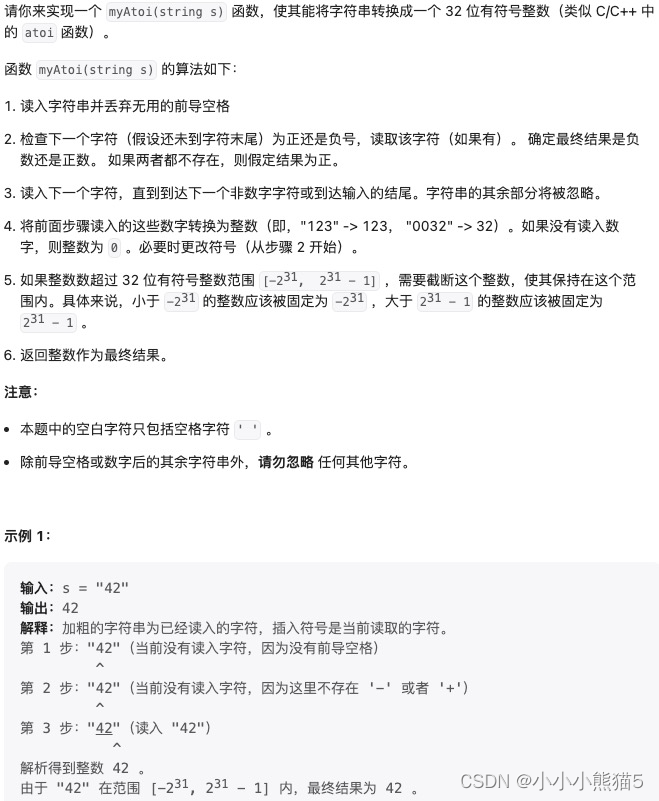
[Go版]算法通关村第十二关青铜——不简单的字符串转换问题
目录 题目:转换成小写字母思路分析:大写字母ASCII码 32 小写字母ASCII码Go代码Go代码-优化: 大写字母ASCII码 | 32 小写字母ASCII码 题目:字符串转换整数(atoi)思路分析:去除首部空格 明确正负 读取数…...
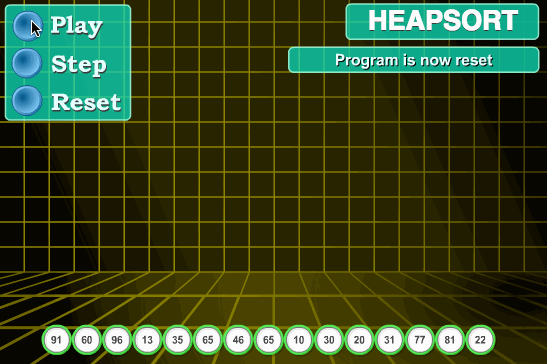
十种排序算法(附动图)
排序算法 一、基本介绍 排序算法比较基础,但是设计到很多计算机科学的想法,如下: 1、比较和非比较的策略 2、迭代和递归的实现 3、分而治之思想 4、最佳、最差、平均情况时间复杂度分析 5、随机算法 二、排序算法的分类 …...

【校招VIP】测试类型之兼容性测试分析
考点介绍: 兼容性是测试工作里面比较复杂的一种情况,也是校招里面考察的一个重点,需要从屏幕功能,数据,操作系统等多个维度进行分析。 『测试类型之兼容性测试分析』相关题目及解析内容可点击文章末尾链接查看&#x…...
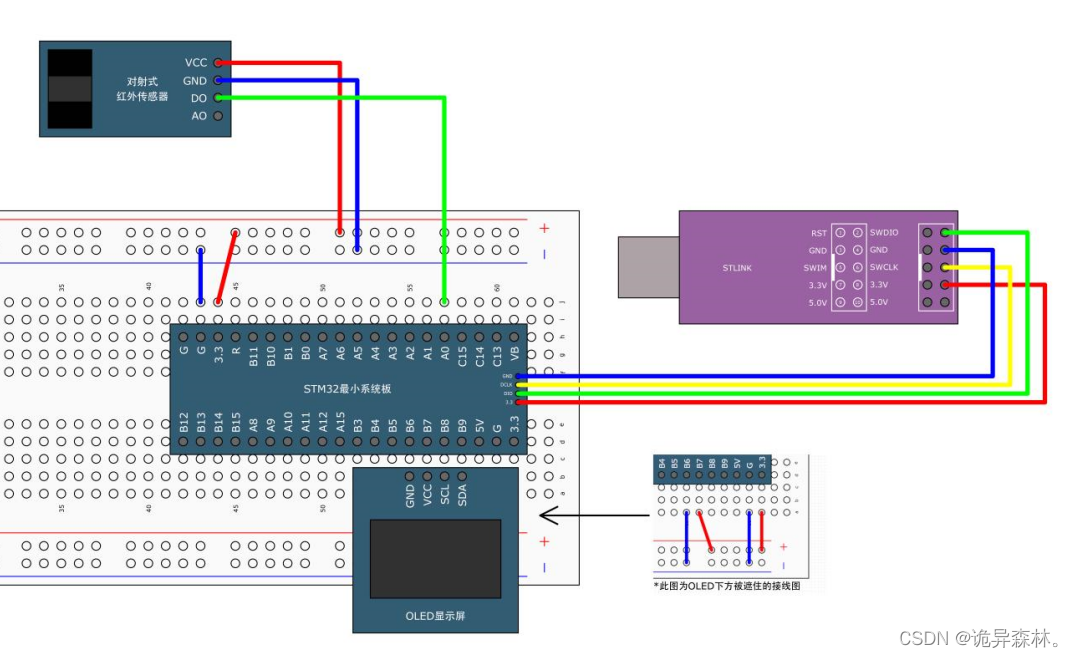
STM32--TIM定时器(1)
文章目录 TIM简介定时器类型 通用定时器预分频器时序计数器时序定时中断基本结构TIM内部中断工程TIM外部中断工程 TIM简介 STM32的TIM(定时器)是一种非常常用的外设,用于实现各种定时和计数功能。它是基于时钟信号进行计数,并在计…...

Android取证——基础知识
目录 一、安卓系统版本 二、安装操作系统UI 三、鉴权码 1.IMEI(手机序列号) 2.ICCID...
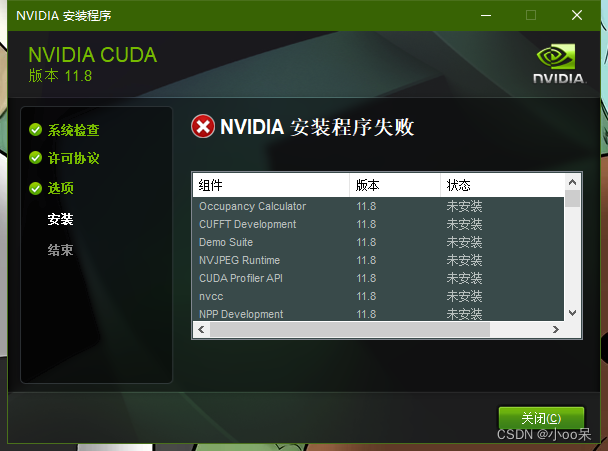
【学习心得】安装cuda/cudann和pytorch
一、查看驱动信息 # 进入CMD输入命令 nvidia-smi 也可以右下角图标打开NVIDIA 设置进行查看 二、下载安装CUDA 1、下载 下载地址 https://developer.nvidia.com/ 2、安装 推荐自定义安装。建议只勾选Cuda,只安装这一个就好,以免报错安装失败。 3、验证…...

中电金信通过KCSP认证 云原生能力获权威认可
中电金信通过KCSP(Kubernetes Certified Service Provider)认证,正式成为CNCF(云原生计算基金会)官方认证的 Kubernetes 服务提供商。 Kubernetes是容器管理编排引擎,底层实现为容器技术,是云原…...

【Spring】Bean的实例化
1、简介 在容器中的Bean要实例化为对象有三种方式 1、构造方法 2、静态工厂 3、实例工厂 4、实现工厂接口 2、构造方法 构造方法实例化Bean即是直接通过构造方法创建对象 <bean id"bookDao" class"com.wn.spring.dao.impl.BookDaoImpl"/> 当不存在…...
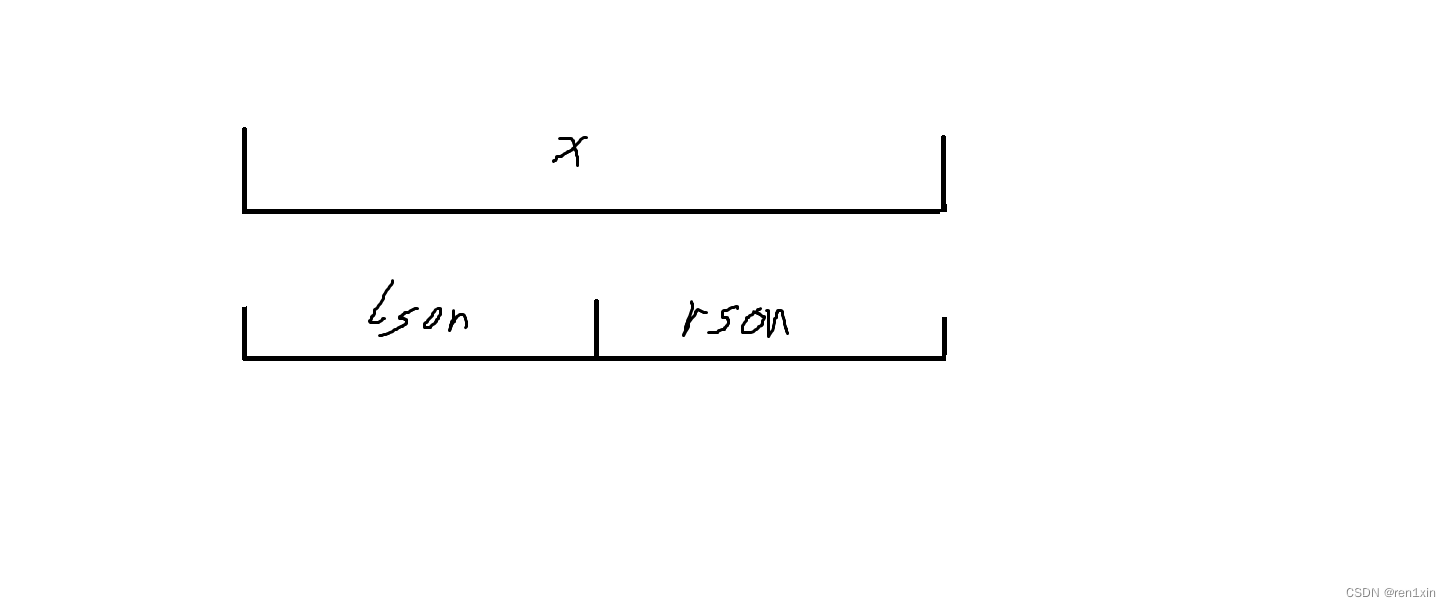
2023牛客暑期多校训练营8-C Clamped Sequence II
2023牛客暑期多校训练营8-C Clamped Sequence II https://ac.nowcoder.com/acm/contest/57362/C 文章目录 2023牛客暑期多校训练营8-C Clamped Sequence II题意解题思路代码 题意 解题思路 先考虑不加紧密度的情况,要支持单点修改,整体查询࿰…...
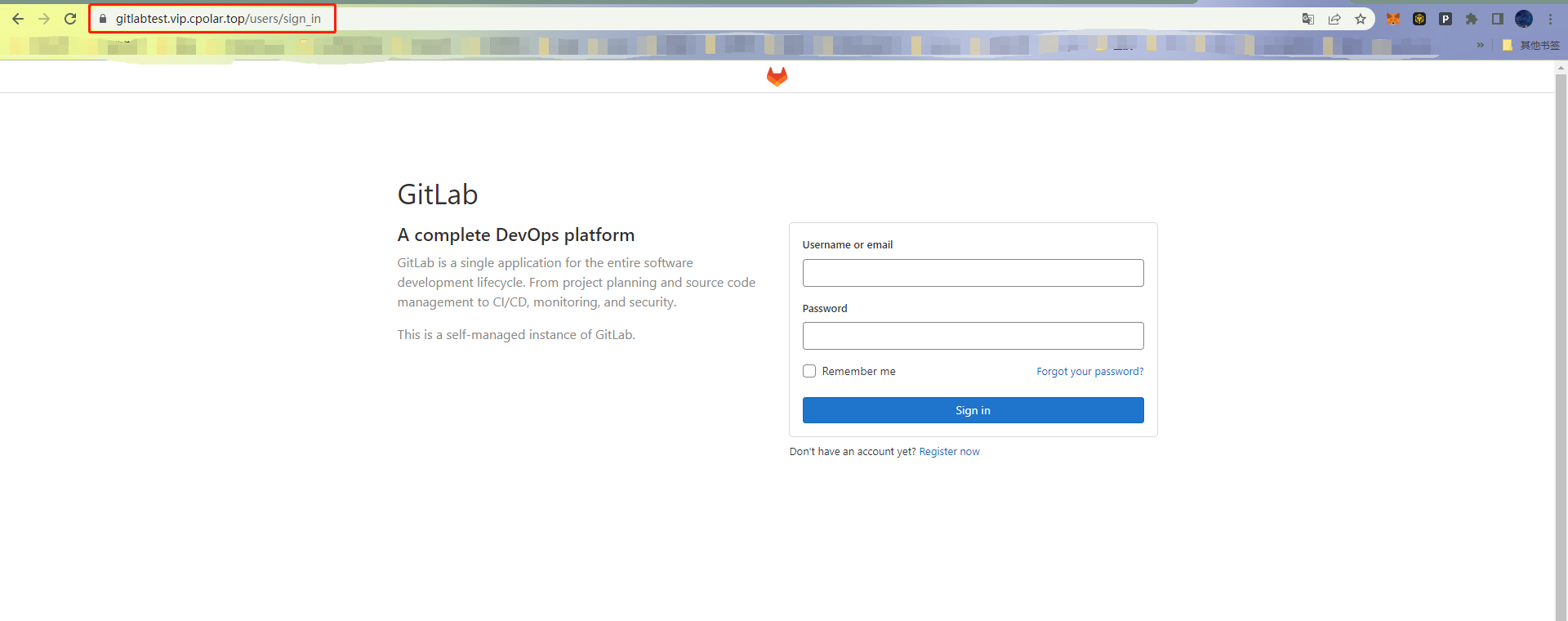
【GitLab私有仓库】如何在Linux上用Gitlab搭建自己的私有库并配置cpolar内网穿透?
文章目录 前言1. 下载Gitlab2. 安装Gitlab3. 启动Gitlab4. 安装cpolar5. 创建隧道配置访问地址6. 固定GitLab访问地址6.1 保留二级子域名6.2 配置二级子域名 7. 测试访问二级子域名 前言 GitLab 是一个用于仓库管理系统的开源项目,使用Git作为代码管理工具…...

企业计算机服务器遭到了locked勒索病毒攻击如何解决,勒索病毒解密
网络技术的不断发展,也为网络安全埋下了隐患,近期,我们收到很多企业的求助,企业的计算机服务器遭到了locked勒索病毒的攻击,导致企业的财务系统内的所有数据被加密无法读取,严重影响了企业的正常运行。最近…...

Redis哨兵模式搭建
Redis主从复制搭建 Redis虽然拥有非常高的性能,但是在实际的生产环境中,使用单机模式还是会产生不少问题的,比如说容易出现 单机故障,容量瓶颈,以及QPS瓶颈等问题。通常环境下,主从复制、哨兵模式、Redis…...

大语言模型控制生成的过程Trick:自定义LogitsProcessor实践
前言 在大模型的生成过程中,部分原生的大语言模型未经过特殊的对齐训练,往往会“胡说八道”的生成一些敏感词语等用户不想生成的词语,最简单粗暴的方式就是在大模型生成的文本之后,添加敏感词库等规则手段进行敏感词过滤…...
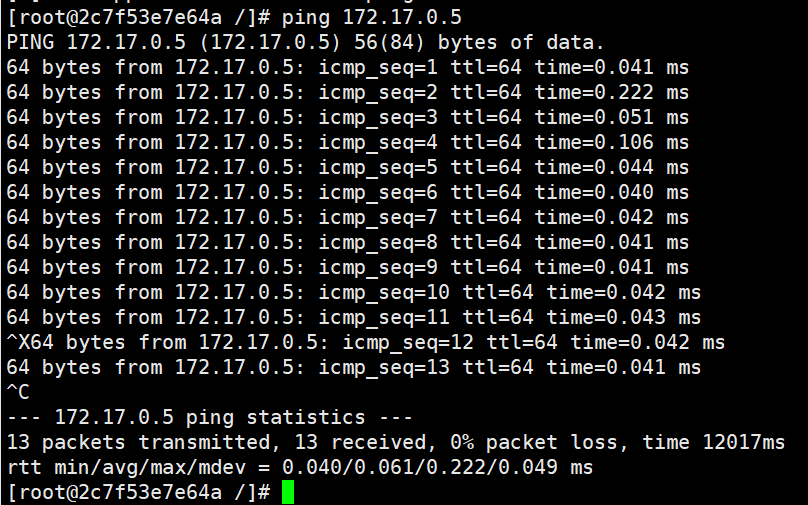
Docker容器:docker的资源控制及docker数据管理
文章目录 一.docker的资源控制1.CPU 资源控制1.1 资源控制工具1.2 cgroups有四大功能1.3 设置CPU使用率上限1.4 进行CPU压力测试1.5 设置50%的比例分配CPU使用时间上限1.6 设置CPU资源占用比(设置多个容器时才有效)1.6.1 两个容器测试cpu1.6.2 设置容器绑…...

从零开始打造家装预约咨询小程序
在如今互联网高度发达的时代,家装行业也逐渐意识到了线上渠道的重要性。为了更好地服务客户,提高用户体验,越来越多的家装公司开始寻找合适的小程序制作平台。本文将向大家介绍如何使用第三方制作平台,如乔拓云网,打造…...

es线上处理命令记录
常用命令 搜索 GET _search {"query": {"match_all": {}} }获取全部模版 GET _index_template GET _index_template/yst_crawler_template获取全部索引 GET /_cat/indices?v 获取当前mapping GET /yst_crawler/_mapping创建一个mapping PUT /yst_c…...
)
mysql 在nodejs中的简单使用(增删改查)
一 、封装SQL查询请求链接 const mysql require(mysql) //创建开发工具数据库链接池 const pool mysql.createPool({host: 192.168.1.133,user: user_name, password: 123456,database: database_name,port: 3306,connectionLimit: 50 // 限制连接数 });// sql:查…...

1.MySQL数据库的基本操作
数据库操作过程: 1.用户在客户端输入 SQL 2.客户端会把 SQL 通过网络发送给服务器 3.服务器执行这个 SQL,把结果返回给客户端 4.客户端收到结果,显示到界面上 数据库的操作 这里的数据库不是代表一个软件,而是代表一个数据集合。 显示当前的数据库 …...

Zabbix-6.4.4 邮箱告警SMS告警配置
目录 ------------------------- # 邮箱告警 ---------------------------------- 1.安装mailx与postfix软件包 2.修改mailx配置文件 3. 创建文件夹 4. 编写mail-send.sh脚本 5. 将该脚本赋予执行权限 6. 进入web界面进行设置—> Alerts —> Media Types 7. 添…...
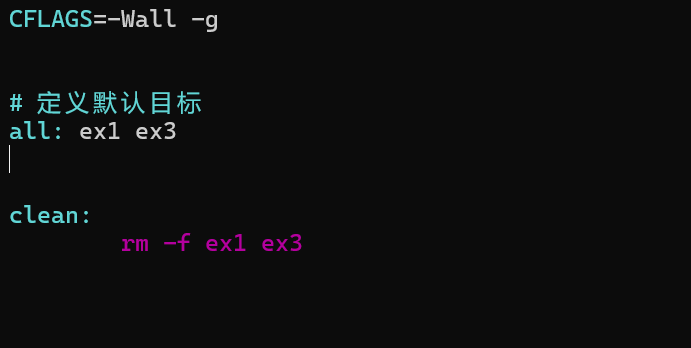
YSYX学习记录(八)
C语言,练习0: 先创建一个文件夹,我用的是物理机: 安装build-essential 练习1: 我注释掉了 #include <stdio.h> 出现下面错误 在你的文本编辑器中打开ex1文件,随机修改或删除一部分,之后…...

CRMEB 框架中 PHP 上传扩展开发:涵盖本地上传及阿里云 OSS、腾讯云 COS、七牛云
目前已有本地上传、阿里云OSS上传、腾讯云COS上传、七牛云上传扩展 扩展入口文件 文件目录 crmeb\services\upload\Upload.php namespace crmeb\services\upload;use crmeb\basic\BaseManager; use think\facade\Config;/*** Class Upload* package crmeb\services\upload* …...
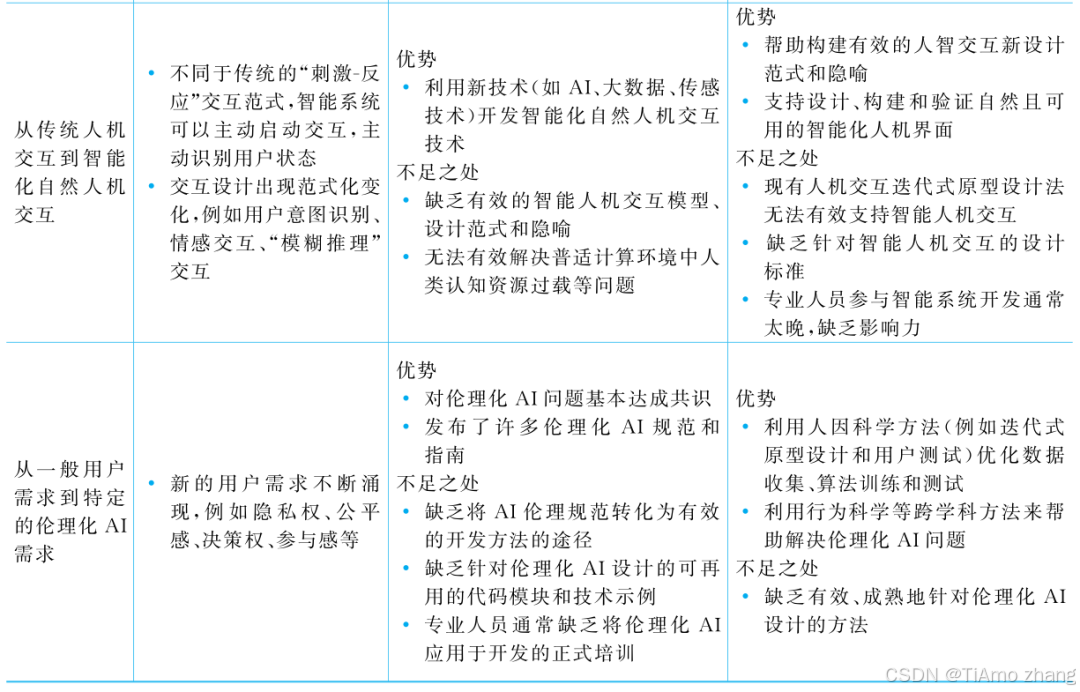
人机融合智能 | “人智交互”跨学科新领域
本文系统地提出基于“以人为中心AI(HCAI)”理念的人-人工智能交互(人智交互)这一跨学科新领域及框架,定义人智交互领域的理念、基本理论和关键问题、方法、开发流程和参与团队等,阐述提出人智交互新领域的意义。然后,提出人智交互研究的三种新范式取向以及它们的意义。最后,总结…...

(一)单例模式
一、前言 单例模式属于六大创建型模式,即在软件设计过程中,主要关注创建对象的结果,并不关心创建对象的过程及细节。创建型设计模式将类对象的实例化过程进行抽象化接口设计,从而隐藏了类对象的实例是如何被创建的,封装了软件系统使用的具体对象类型。 六大创建型模式包括…...
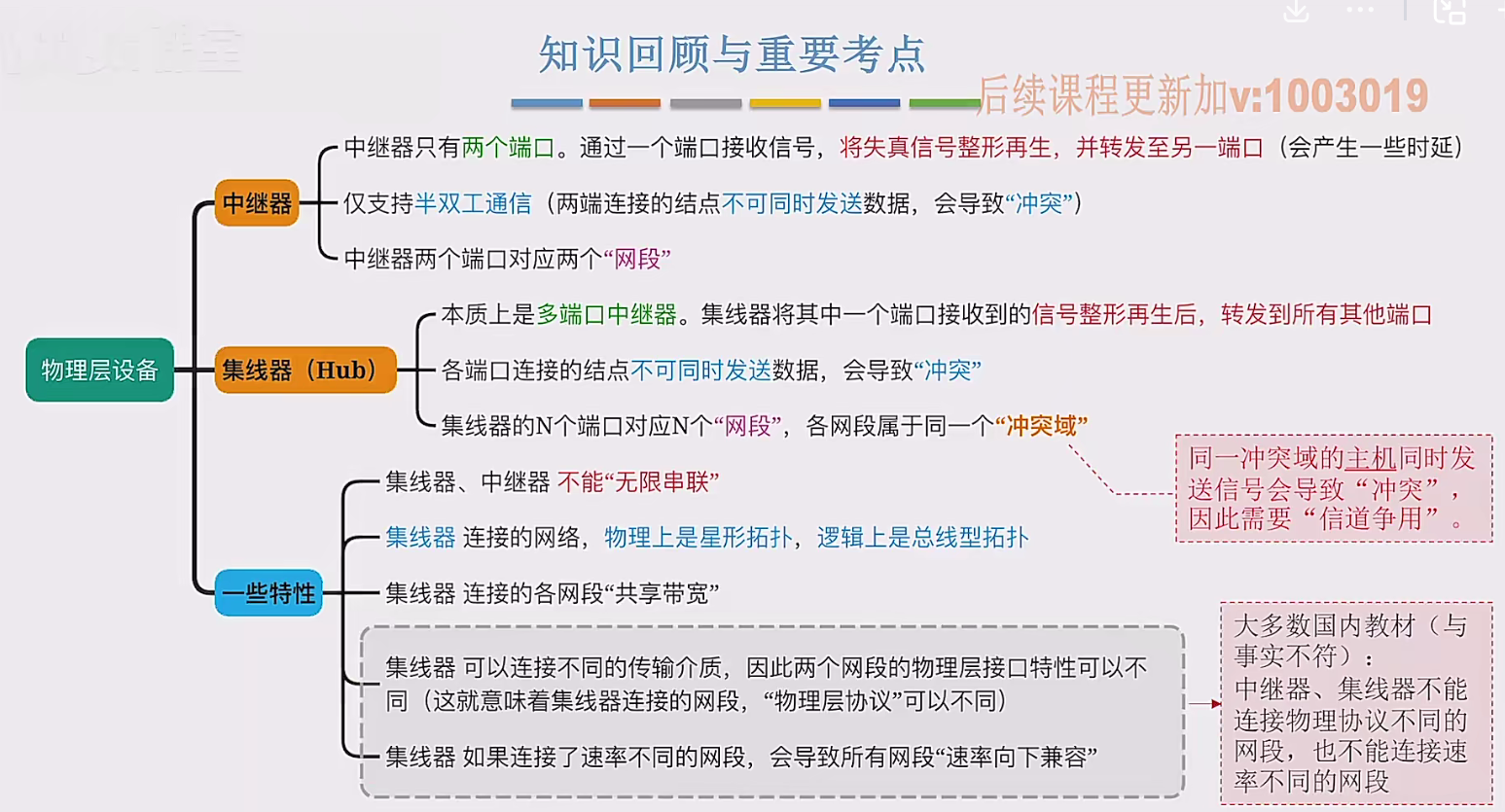
2.3 物理层设备
在这个视频中,我们要学习工作在物理层的两种网络设备,分别是中继器和集线器。首先来看中继器。在计算机网络中两个节点之间,需要通过物理传输媒体或者说物理传输介质进行连接。像同轴电缆、双绞线就是典型的传输介质,假设A节点要给…...

Appium下载安装配置保姆教程(图文详解)
目录 一、Appium软件介绍 1.特点 2.工作原理 3.应用场景 二、环境准备 安装 Node.js 安装 Appium 安装 JDK 安装 Android SDK 安装Python及依赖包 三、安装教程 1.Node.js安装 1.1.下载Node 1.2.安装程序 1.3.配置npm仓储和缓存 1.4. 配置环境 1.5.测试Node.j…...

【Java多线程从青铜到王者】单例设计模式(八)
wait和sleep的区别 我们的wait也是提供了一个还有超时时间的版本,sleep也是可以指定时间的,也就是说时间一到就会解除阻塞,继续执行 wait和sleep都能被提前唤醒(虽然时间还没有到也可以提前唤醒),wait能被notify提前唤醒…...

Java中HashMap底层原理深度解析:从数据结构到红黑树优化
一、HashMap概述与核心特性 HashMap作为Java集合框架中最常用的数据结构之一,是基于哈希表的Map接口非同步实现。它允许使用null键和null值(但只能有一个null键),并且不保证映射顺序的恒久不变。与Hashtable相比,Hash…...

第22节 Node.js JXcore 打包
Node.js是一个开放源代码、跨平台的、用于服务器端和网络应用的运行环境。 JXcore是一个支持多线程的 Node.js 发行版本,基本不需要对你现有的代码做任何改动就可以直接线程安全地以多线程运行。 本文主要介绍JXcore的打包功能。 JXcore 安装 下载JXcore安装包&a…...

npm安装electron下载太慢,导致报错
npm安装electron下载太慢,导致报错 背景 想学习electron框架做个桌面应用,卡在了安装依赖(无语了)。。。一开始以为node版本或者npm版本太低问题,调整版本后还是报错。偶尔执行install命令后,可以开始下载…...







